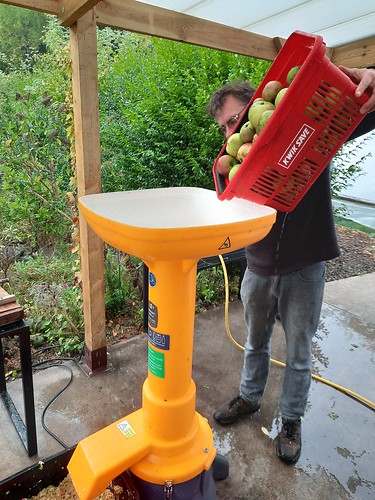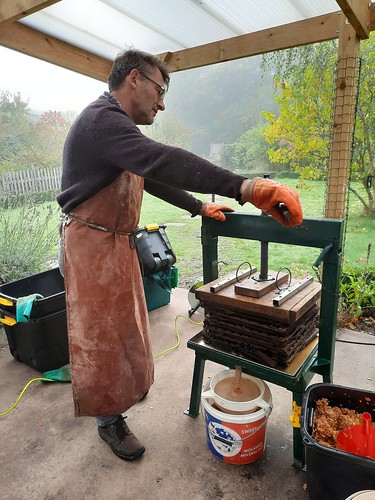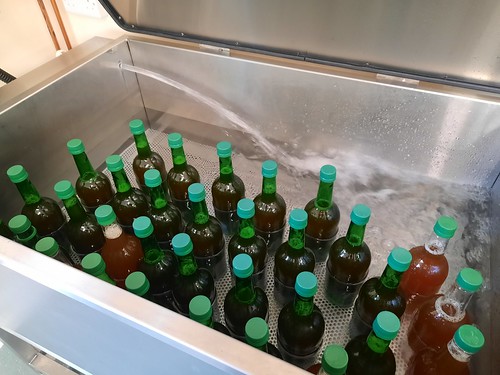As promised in my last post, and before winter claims what is left of lingering autumn feels, here is a little account of how we pressed our homegrown apples into bottles and bottles of lovely, organic juice.
One crisp and sunny morning in October, we drove our 60 kgs of harvested apples, mainly Bramleys, to Newtown, where we had hired a pressing, juicing and pasteurising facility. A couple of years ago, we had tried juicing at home with a small, domestic juicer that some friends had lent us and the process was slow, messy and very noisy! The machine had to be given regular breaks to prevent it from clogging or overheating and it took us several evenings to process a basket of apples. And then we had to freeze the juice which, given the length of time it was taking to process, quickly turned a rusty, oxidised colour that we found a little off-putting even though it tasted just fine!
When we discovered that the equipment was available to hire at the community gardens in the next town, we jumped at the chance to take our Bramleys there to be processed - and pasteurised so that we could include our own juice in the breakfast baskets of our shepherd's hut guests whilst complying with food hygiene regulations.
Dressed with protective aprons and gloves, we first washed the apples in a big vat of water, sloshing them around with a dedicated broom to rid them of any dirt, dust or insects (we must remember to wear wellies next time - our feet got soaked!!). Then, we emptied the fruits, whole, into the big funnel of the electric milling machine that, in no time at all, had crushed our apples into a delicious pomace of the perfect consistency to extract juice easily and of best quality when pressing. It separated the pulp out and we bagged this up to take home for the compost.
Soon, we were filling trays of woven mesh and wooden frames with the milled apples, stacking them on top of each other in the press. Peter was in charge of this bit whilst I washed the bottles ready to be filled with the golden juice that was about to pour out of the press spout. We tasted it before we bottled it and its tangy taste, full of flavour, was just delicious!
We filled 34 glass bottles of 75 cl, which we placed in the pasteuriser as we went along. We bought 30 new bottles with fresh screw caps especially for the occasion (we knew that juice yield is around half of the weight of the apples) and we plan on re-using them next time. We had to top up our bottle supply with a few used ones (I keep a lot of empty bottles in the pantry so I was prepared!).
The pasteuriser was a big water tank that heated up the contents of the bottles to 75 degrees and sustained that temperature for around 25 minutes. This aim of this process is to kill off any organisms that could spoil the juice and to preserve its fresh apple flavour. Being able to pasteurise makes such a difference to the juice's shelf life and storage. We have been told that pasteurised apple juice will keep for 18 to 24 months, so it was really useful for such a quantity of juice to keep. I don't think that ours will last that long!
It took us around 4 hours to process 60 kgs of apples and the pasteurising process (heating a vat 3/4 full of water took about an hour) took the longest time. We drove home with chinking bottles in cardboard boxes in the back and a satisfying grin on our faces, grateful for the chance to use large, communal facilities for our supply of fresh apple juice to last us several months - and to gift too.
We took some warmed apple juice in a flask to the fireworks and bonfire event in the next village at the beginning of November. During the festive season, we will enjoy warm mulled apple juice as an alcohol-free alternative to the traditional mulled wine. Or maybe mix both? Cheers!







Cor! What a nice way to use up those apples. We have loads here off Graham's trees which he does nothing with. So I've collected as many as I could and have given at least half away and the others are storing in his wine cellar which is cool and perfect for them. And mice free too. Last year they kept us in apple crumble until around March. Well done you two.
Posted on By Guy
Thanks, Guy. We also have some apples left for crumbles and pies!
Posted on By Maryline